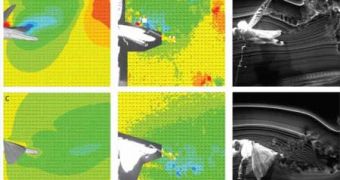Recent scientific studies conducted on insect flight have revealed that nature and evolution seem to favor a wing design that is not flat and inflexible, such as airplane wings. While they may get the job done transporting humans from point A to point B, they are not highly efficient in terms of performances, when compared, for instance, with the wings of the average mosquito. Slow-motion films and gas-chamber tests have revealed that most insects feature wings that bend and twist while in flight, an ability that apparently plays a crucial role in the flying process, LiveScience reports.
In an attempt to create one of the most accurate models to date of insect flight, a team of scientists from the University of New South Wales (UNSW), in Australia, led by expert John Young, has studied locusts in carefully set up laboratory environments. The investigators used high-speed, digital cameras to photograph the small bugs in mid-flight, and noticed that their wings were powerfully curved while they moved. The scientists then took their results, and fed them to a 3D computer simulation.
This was the first model to take the curvature of the wings into account when modeling the insects' flight. As the simulation ran, scientists continuously added or extracted features from the wings, so as to determine precisely what effects each of the traits had on the overall flying process. “If you change from a flat-plane wing to a twisted wing, it requires 50 percent less power to generate the same lift, which is a huge savings,” University of Oxford scientist Adrian Thomas, who has also been the co-author of the new study, explains. The finds are detailed in the September 18th issue of the journal Science.
“The carefully-tuned shape the locusts have generates the lift without the costly drag,” Thomas says. The team noticed that curved wings caused only the minimum amount of downward dragging, while at the same time generating more lift, and this is the a lesson of efficiency. “We found substantial differences in the induced airflows. Our results suggest that the flexible wings are doing a better job of transferring lift-favorable momentum,” University of Washington graduate student Andrew Mountcastle, who has conducted another study on the theme, explains.

 14 DAY TRIAL //
14 DAY TRIAL //